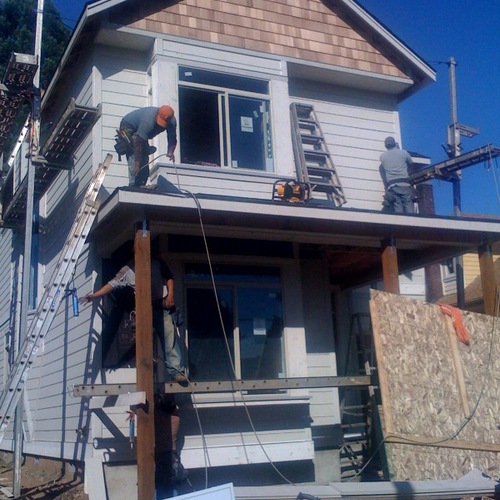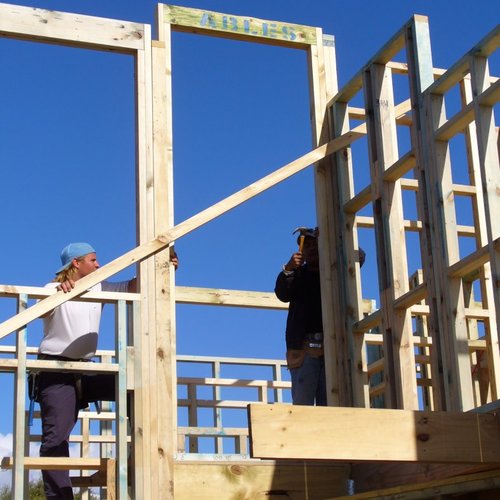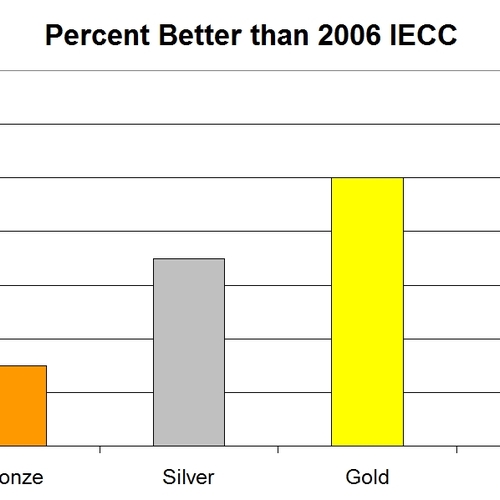
Image Credit: Martin Holladay
“Techno Toys” May Have a Long Payback Period
LAS VEGAS, NV — Architect Peter Pfeiffer of Austin, Texas, has been involved with green building design since 1983. During his 26-year architectural career, Pfeiffer has had plenty of time to hone his theories of green design. In an informative workshop at this week’s International Builders’ Show in Las Vegas, Pfeiffer shared tips with interested builders and architects. Here are some of his observations.
* “Builders and architects need to be good guidance counselors to help clients make good decisions. Don’t underestimate the value of discussing the obvious with your clients.”
* “A lot of the green buildings we see are what I call vitamin-enriched cigarette houses. When you smoke a vitamin-enriched cigarette, are you better off or worse off? Here’s an example — a ‘green’ home with solar panels on the roof. But why didn’t the designer remember to shade the windows?”
* “I try to avoid projects with an attached garage. Attached garages are associated with indoor air quality problems. We try to talk folks into doing a detached garage, or a detached garage with a breezeway.”
* “We need to prioritize our green strategies. At my own house, I have a $26,000 photovoltaic system that saves me about $35 of electricity a month. But I recently invested in an efficient pool pump that cost me only $800. That $800 pump saves me $65 a month — a lot more than the $26,000 PV system.”
* “Stucco-clad buildings without adequate roof overhangs are risky. Stucco is a moisture-absorbing cladding. Here’s a photo of a stucco building without overhangs. After a few years, the builder had to strip all of the stucco off to address moisture problems.”
* “I’m not very excited about flex duct. I consider flex duct to be temporary ducting.”
* “To sum up, it’s important to educate your clients in the programming phase of the project. It’s important to understand the building science behind the buildings you design. And we should reduce our reliance on techno toys.”
Weekly Newsletter
Get building science and energy efficiency advice, plus special offers, in your inbox.















14 Comments
* "Stucco-clad buildings
* "Stucco-clad buildings without adequate roof overhangs are risky. Stucco is a moisture-absorbing cladding. Here’s a photo of a stucco building without overhangs. After a few years, the builder had to strip all of the stucco off to address moisture problems.”
That's exactly whats wrong with this House
https://www.greenbuildingadvisor.com/homes/leed-platinum-house-warm-climate
Peter is spot-on about overhangs!
As a Texas Architect ...I
As a Texas Architect ...I have learned much from Peter Peiffer.
One thing that I will question Peter about is his often said statement that "wall r-value is not so important in our climate".
If you run the numbers and just look at the heat loss/gain coefficients..
wall r-value is a big piece of the pie.
Maybe he has backed off of this?
Peter ? are you out there?
Here is a Peter Pfeiffer
Here is a Peter Pfeiffer quote concerning wall R-value in Texas:
"once you hit about r-13, you're really reaching a point of diminishing returns"
I would say that it may not make a great deal of difference in a poorly built home..but wall r-value can have a significant impact on a high performance home...even in a Hot Humid climate.
Conductive heat gains and losses are always there..they do not go away unless the outside temperature is near the desired inside temperature...
We are required by code to have rather high r-values in the roof and ceiling assemblies... so there is not as much room for improvement in the ceiling r-value.
The wall surface area is almost always greater than ceiling area...sometimes much greater...therfore upgrading wall insulation can have a greater impact.
R value
I concur with my good friend Peter's assessment of wall R value in moderate climates. Not to suggest that you leave out or reduce insulation, but if you hyper focus on wall insulation and miss other opportunities to make the house more efficient such as air sealing, radiant barriers, window shading, etc, then you may well end up with a less efficient and healthy structure. Also, when you are dealing with existing homes that have little or no insulation in the walls, if you are adding it into existing wall cavities, you can create serious moisture problems where they did not previously exist, allowing mold to form and causing wood structures that lasted decades to suddenly start to deteriorate.
Carl,
Not sure that I would
Carl,
Not sure that I would call Hot Humid or even Mixed Humid a moderate climate.
I am talking about new construcion...not remodels.
Of course we have to do all of the things that you mentioned...and we have to balance the things we choose to do.
I pretty much thought that Peter's message about wall r-value made sense until I started looking deeper. I designed a house with mostly 2x4 walls (based on Peter's message) I doubled up some of the walls to deal with some plumbing on exterior walls...since I had the space ...I upgraded the open cell foam to seven inches in those walls...I notified my HERS provider and he updated my HERS report.
To my surprise..there was a noticeable improvement in projected energy consumption.
I wish now that I would have paid more attention to wall r-value and upgraded all of my walls.
Ask your HERS provider to do a little experiment (upgrade your overall wall r-value)and you will see what I mean.
JB
We may have to agree to disagree
Isn't it great that we can argue about things like this? In climates where the temperature difference between the inside and outside is generally less than 30 degrees, wall insulation is much less critical than the other issues I mentioned. A HERS rating may be better with more insulation, but the software used for this is far from perfect, and, as a matter of fact, does not give enough value to very effective elements such as insulated rooflines, in effect penalizing those who use some more efficient techniques. In cold climates, certainly more insulation is better, but I do agree with Peter, that in moderate and even hot climates, you can reach a point of diminishing return with wall insulation. This is particularly the case if there is a lot of glazing in the walls.
wall - r-value
Carl,
Thanks for discussing this.. nice to get a southern point of view.
Of course we need excellent air barriers, healthy ventilation and wise architectural design to improve energy efficiency and durability.
I realize that upgrading wall insulation beyond the minimum energy code levels can be very costly.
We either must wrap the structure with rigid insulation or use costly closed cell foam or finely tune the framing design or else increase the wall thickness.
Increasing the wall thickness will bite us twice. Foundations and roof area will be increased...trades that charge by the square foot will add costs.
Permit fees..foundation engineers...cleanup crews..yadayada.
Then we get to pay property tax on the extra square feet! year after year
So there are good $ reasons to avoid it.
Does better than minimum code wall insulation save significant energy?
Does it only save energy in cold climates????
What does a 30 degree delta-T have to do with the price of tomatoes?
Some cold climates have large delta-T for 3 to 5 months and then mild conditions for the rest of the year...
We may not need R-40 walls in Texas.. but R-13???
We probably only get one chance to improve our walls.
As far as "a lot of glazing" goes...just don't over-glaze as many Architects and Builders love to do.
oops carl
oops Carl,
I see you are not exactly a Southerner
no disrespect.
JB
Walls vrs. ?
I'll chime in for sweating all the details not just the walls.
I see a lot of the green builders out there getting all excited about SIPs and ICFs and the money and time they invest in these systems often would be better invested in air tightening and duct sealing a conventionally framed house and pushing the envelope in other ways, as you mention John.
I agree with your comments about over-glazing, which I'm guilty of, but I think your concern about the added cost of the square footage under the thicker walls is a red herring. the incremental cost increase of using 6 vrs 4 inch walls is actually pretty minor and the property tax impact seems pretty negligible in my experience. I'm building a stick framed house with 12" thick walls here in NC. The added cost was pretty minimal compared to what it would have cost to build it with 9" ICF's.
The core issue in my opinion is bulk air movement (in the majority of homes) If we can only increase the budget for a limited number of energy upgrades I think we need to focus there, seal attics, roofs and duct work, and eliminate drafty windows and doors. Then go after the water heater since it runs in good weather and bad.
In the end it doesn't matter what the R-value of the wall is if the door is open.
Red Minnow
Michael,
My crusade is the air barrier and healthy ventilation.
I think your choice to improve your wall is wise..perhaps a long payback..but nonetheless wise.
You obviuosly believe that wall r-value is impotant. I think that conductive losses and gains are more a function of heating and cooling degree days than of maximum delta-T swings.
Concerning the cost of thicker walls...I think it is more than a red minnow ;-)
I estimate that if you upgrade the wall from 4 inch to 6 inch...it will add about 50 sf to a 3000 sf house.
So depending on what "raw" footage costs you per s.f. then you can do your own math.
I would assume advanced(or wise) framing for the 4 inch wall or the 6 inch wall so there will be an increase in framing lumber costs.
There is also the extra cost for the insulation(noticed you use $$ open cell) and jamb extensions.
I estimate the added property tax to be over $100 this year and next year..and likely increase every year. Property tax is the gift that keeps on giving!
Of course when the wall thickness goes beyond 6 inches..the costs and property taxes continue to rise.
I'm OK being called a southerner
Although I am originally from NY, I have lived in the south for over 30 years, so I accept that I am a southerner. As to the R value of walls, I agree that we shouldn't stop at R13 - I suggest 19-22, depending on the material, in my climate. The real issue is the balance of all the techniques in a project, the most important one being the proper installation of the insulation material itself. If someone decides to install R40 fiberglass without an air barrier, they are terribly misguided, and we need to tell them that. I am a big fan of spray foam, and spend a lot of time pointing out that the actual cost difference between it and fiberglass, once you account for all the extra air sealing required and other benefits such as reduction in HVAC equipment size, is actually quite small. If you want to do it right, you end up spending money somewhere - materials (expensive insulation) or labor (careful air sealing) -I don't care which way you go, but you've got to do it right.
We all agree on the spray foam
Carl,
I am looking into Air tight drywall techniques...but so far I am sticking with spray foam because It has provided an extremely tight air barrier. I can't find anyone around here(N.Texas) with the tight Drywall experience.
Something you wrote made me think you were from the North..but I see now you are a southerner.
Most of the info and feedback I get is from the cold climatists. Even the textbooks I have were written for cold climates.
Most of all the good building science has started in the cold climates.
Peter's Southern Perspective is very good and I agree with 98%.
The 2% exception:
1% is the wall r-value and 1% is the ventilated cathedral ceiling.
It still makes more sense to me to spray the foam directly to the underside of the roof deck.(in Mixed humid climate)
Anyway glad that you and Michael are posting here.
R value is important - when applied right
John and others:
I do believe conductive R-value is important - when applied correctly and understanding the other factors that apply. In my talks I attack this notion that R-value within the wall cavity is omnipotent. It's just one part of the equation - Delta T, insulating factor of the sheathing, air flow, radiant heat gain through glass, etc. all have to come into play. You all know this already, however. (I just went through the blog.)
One of you already mentioned it but it is worth repeating: The wall cavity fill only makes up about 2/3 to 3/4 the wall surface area. Therefore, an insulating sheathing ("outsulation") of signifcance (3/4" for you John in the DFW area)over a rigid sheathing is a critical part of the total wall construction.
Looking forward to this dialogue! (Never done the blog thing before this. Carl knuckled me into it...)
Those Dallas Architects
Peter,
I am glad that you joined the discussion. That was the hope of my original post.
This is a good chance for me to say that your speech in Coral Gables three years ago inspired me to rethink everything.
I realized that I was one of "those Dallas Architects" who built homes with inadequate overhangs and not enough respect for the sun. I had no idea what an air barrier was.
I have been hitting it hard for three years and I continue to learn how much I don't know.
To be fair to you .. you did recomend that I use rigid insulation on my personal home and I chose to not hassle with it because I had also heard the message that "wall r-value is not so important".
The rigid insulation does add expense and some challenges around window and door openings.
But it has a LOT of advantages and it does not carry the minor tax penalty of the extra thick walls.
Glad you said outsulation OVER a rigid sheathing.
Log in or create an account to post a comment.
Sign up Log in